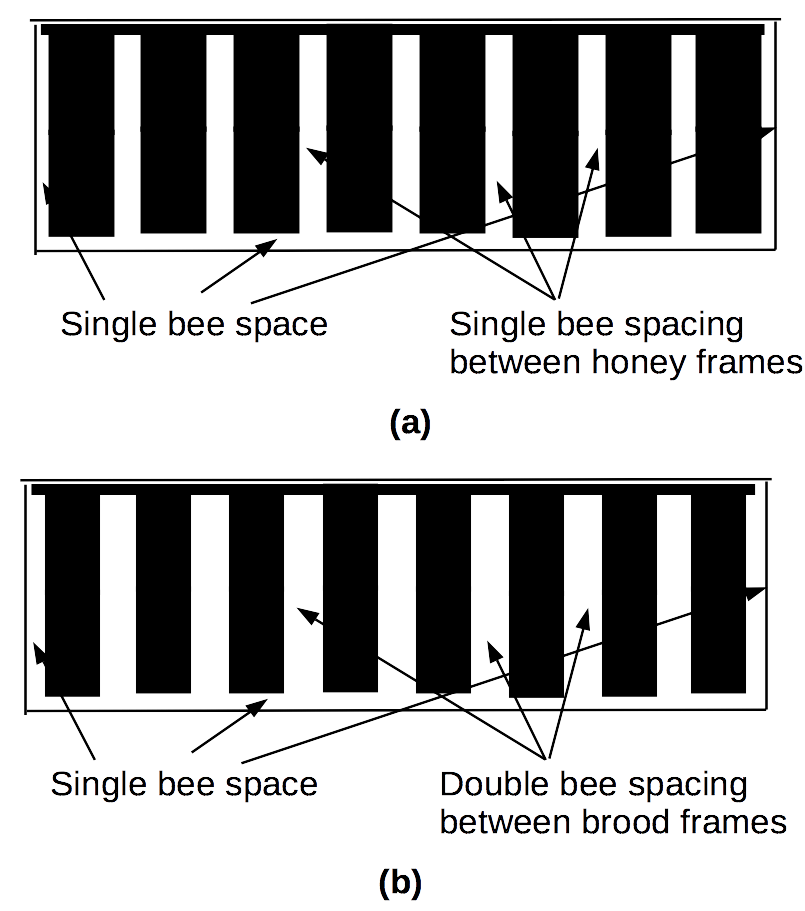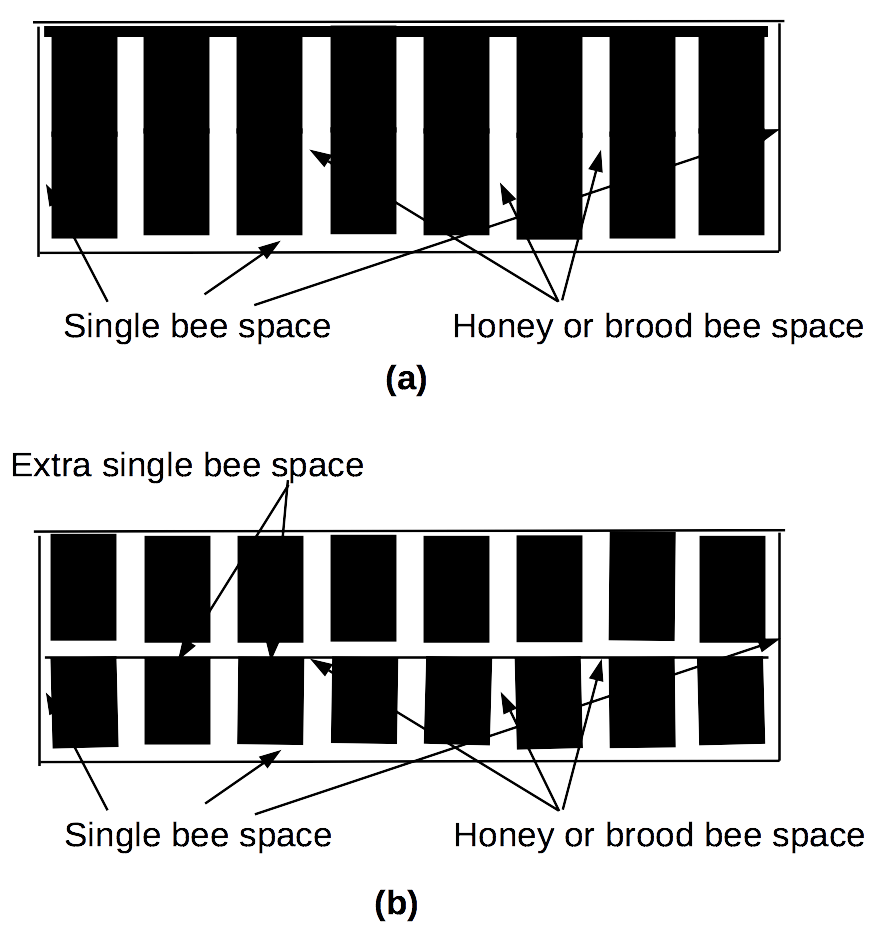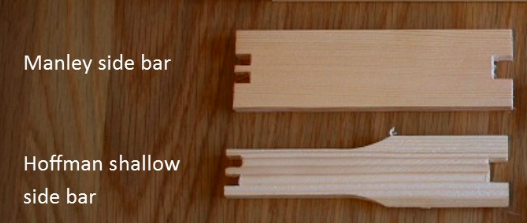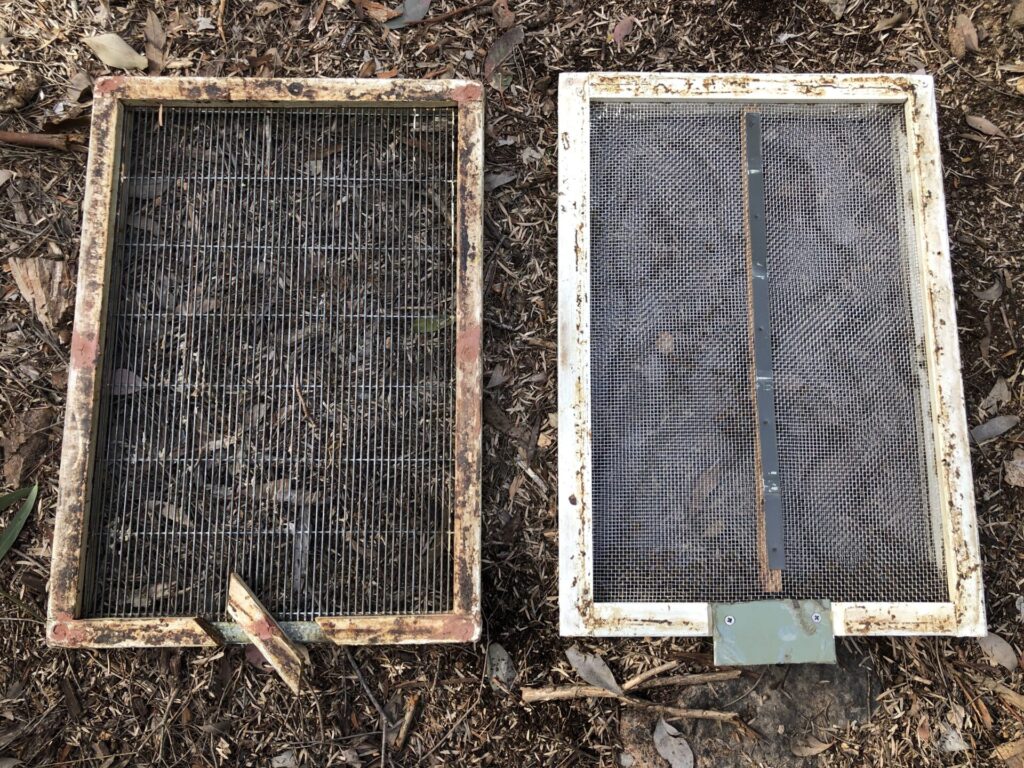
Alan Wade and Frank Derwent
Many beekeepers make claim to understanding bee space. Indeed it is one of the fundamentals tenets of beekeeping that is taught to beginners. Anything bigger than a bee space will be filled with comb and anything smaller will be filled with propolis. Bee space is that 8-10 mm gap, in the old imperial measurement 3/8”, needed to allow bees to move freely from one location to another in the catacomb that is the nest of the honey bee hive. Despite this known ‘known’ we are surprised that theory and practice are not very much on the same page.
An understanding of bee space tells us that with too much space bees will either increase the width of combs – increasing their effective storage capacity – or fill the void with burr and brace comb. When an examination is made of the sizes of available hive furniture (boxes, lids, bases and frames), we see a common mismatch of frame and hive body depth – not providing the exact bee space – that results, for example, in bottom bars being cemented to the top bars of supers belowi. This type of problem is a legacy of differences in how different bee gear manufacturers view bee space, a lack of common consensus on hive and frame dimensions and variable specifications adopted by governing agencies.
The imposition of an industry standard, that is mandating a uniform 9 mm bee space and uniform measurements for all manufactured hive furniture, would be onerous and meet strong opposition. However this is what would be required if many of the design mismatch problems were to be overcome.
As many of us have experienced, make the gap too narrow and you will give the bees a choice: they will either chew out the comb matrix to allow passage of bees or plug the gap with propolis. Leave out the hive mat under a migratory hive lid, and you will fill the roof space with comb honey with a maze of beeways.
The master Scottish beekeeper Bernhard Möbus noted that the single space, needed to prevent cross bracing of combs and to avoid attachment of combs to walls, is almost doubled between brood combsii. While this increased spacing allows bees to simultaneously tend both sides of the brood and facilitates closer packing of bees in the winter cluster, the very narrow bee-way between honey combs restricts air movement and is important in maximising the insulating value of honey above brood. Möbus also suggests that the narrowness of this space may have been important in evolving the relatively small body size of cavity dwelling honey bees.
In our previous article on hive architectureiii we noted Morse and Seeley’s finding of a distinct bee preference for a nesting cavity size of around 42 L. We also examined features of hive architecture that impacted on colony performance but did not evaluate how bees utilise the space made available to them. It would seem that the topic of ‘bee space’ gives us license to ‘air our views’.
How bees apportion space in a tree hollow cavity
For an informed overview of bee nests in hollow trees it is well worth turning to the wisdom of Tom Seeley and his book The lives of beesiv where he starts out his chapter on the honey bee nest with this insight:
We shall see that when colonies live under a beekeeper’s supervision in wooden hives, rather than in their own hollow trees, they are forced to cope with homes that are often jumbo-sized, poorly insulated and closely spaced.
To this we might add:
Bees have to live with partitioned hive interiors that may be less than conducive to efficient use of the space available.
But in the wild, and short of gnawing loose any fibrous material and shoring up crevices with propolis and wax, honey bees are constrained by the walls of the cavity they inherit. In attaching their combs to the cavity roof and adjusting their points of attachment to match the natural hanging surface, bees can fill out the whole space with comb, only making provision for their free movement and ventilation. Like the development of stalactites in a limestone cave bees build downwards but they control the space-filling architecture.
Suppose a swarm enters an empty full depth 8-frame Langstroth box of internal capacity of 34.8 L (see Table 1). The volume of this box is just short of the optimal size sought by swarms, but this space will be increased by the bottom board riser depth.
To this box let’s add eight equally-spaced foundation starter strips (that is to the underside of a close fitting telescopic lid) to simulate bees starting combs in a natural cavity. We might then expect the bees to draw out perfectly parallel combs leaving a single bee space around the four walls and between the floor and bottom edge of each comb.
In practice, of course, the bees create an impenetrable labyrinth. However, having opened many possum boxes, we can attest to having found large sheets of vertical well-spaced combs, never well aligned, but following the general pattern of proper comb spacing.
So set up, we first notice that the bees leave a 9 mm gap between comb storing honey and pollen (Figure 1a). We then observe a relatively large gap between sealed worker comb surfaces (Figure 1b), but rather less interstitial space where drone comb is present. For a full box this translates to a maximum of 24.7 L (73%) of the total space being utilised for honey storage but only 21.6 L (62%) if all the space available were given over to raising worker brood. In estimating this space for brood we are further indebted to Möbus who pointed out that capped worker cells spans about 25 mm across the comb septum.

Figure 1 Bee space in free-comb built into a standard full depth Langstroth 8-frame hive body:
(a) occupied wholly by stored honey with 9 mm single bee space between sealed store comb faces; and
(b) fully laid out worker brood comb with ~13 mm space between sealed worker brood surface, the shaded black combs being ~25 mm wide.
Notes: Standard Hoffman frames are 35 mm wide at the shoulder, and an 8-frame super is 329 mm wide internally. With 8 frames this allows a gap between each frame of ~4 mm.
As an aside, it is interesting to note that with an Iodice Kenyan Top Bar (KTB) hivev with the same 35 mm top bar width, and with combs built to within 9 mm of sloping walls and the floor with a single bee space between combs all round, comb occupies about 55 L (72%) of the total 76.6 L working capacity. The greater theoretical efficiency of use of space – below the roof formed by top bars – arises from the fact that bees are able to form free form comb. This efficiency is almost identical to that achieved where bees invade an empty rectangular box (as in Figure 1a).
We can now turn to the situation where the comb space is broken up. We start with the same scenario of a swarm settling the same empty super and forming perfect evenly-spaced combs hanging from a flat hive cover. But, let us say, rather than the one full depth box, we now examine the space allocation where there are two half depth boxes.
Here we ‘fake a false ceiling’ by inserting thin wooden slats to start the lower combs. So rather than a single full depth super 244 mm deep (Figure 2a) we now have two half depth supers (Figure 2b) with the same equivalent total void space of 34.8 L (or 2×17.4 L). Notice, however, that there is now a 9 mm gap between the two half depth boxes. This reduces the overall usable space by an additional 3.7% (1.3 L). This small space penalty is always incurred where multiple brood boxes and honey supers are used.

Figure 2 Bee space in free-comb built into:
(a) a standard full depth Langstroth 8-frame hive body; and
(b) a double half depth Langstroth 8-frame hive body with additional bee space between supers.
Comb in wild hives also varies naturally in width. Dave Cushman records that spacing between comb centres of any reasonable size is usually 36-38 mmv, although this may vary slightly where there are small pieces of infill comb. We can now turn to ‘man-maid’ hives to see how bees accommodate a built environment fitted out with standard rectangular frames.
Bee use of space in the frame hive
For the bees, what are the essential design tradeoffs between the cavity space and the comb area available for storage and raising brood? The only free space is the single bee space that that exists between combs of honey, or the roughly double bee space between adjacent sealed brood and the bee space that exists between bee frames and cavity walls. The natural constraints encountered in wild hives such as honeycomb stress loading – governed by the depth of comb from the point attachment to the roof – and the ventilation dynamics needed to supply oxygen and remove carbon dioxide from the hive cavity and maintain water balance, are largely overcome in any well-designed frame hive.
With regular frame hives we find we need only to discount the total volume of materials that make up the frame and the additional space lost between frame components (e.g. between frame edge rims) to calculate the usable space available to the bees. The overall space allocation requirements are the need to provide access highways (the amount of urban space taken up by roads and car parks), the need to provide perimeter access and, in the case of the moveable frame hive, the facility to make the frames movable (i.e. not attached to the roof) and avoiding any attachment of comb to hive walls.
Bee space, first observed by François Hubervi, was put to practical effect by the Reverend Lorenzo Lorraine Langstrothvii in his design of the modern frame hive. In examining the overarching features hive design – wide versus narrow hive body designs, ventilation features and the value of insulation – we examined these overall features but not the details of the internal use of space.
Hive dimensions
Hive body widths and depths vary considerably but are constrained by the natural limits of bees to manage the space available. Shallower hive bodies have significantly less effective brood rearing and storage space per unit volume while more closely packed frames offer more brood rearing area though reducing effective storage space.
For bees, the requirement of the colony to exercise climate control over the hive void must be traded against the available comb space area for raising brood and storing and curing nectar and pollen. Too much hive space – and poor insulation – and the bees will have an unavoidable heating and cooling bills. Too little space to raise brood and to put away stores – a lack of real estate – will severely inhibit colony development and promote swarming or, under extreme circumstances, occasionally encourage absconding. Further a poorly configured hive giving little attention to bee space tolerances will result, as we have seen, in construction of burr and brace comb and the propolisation of gaps.
Frame design
There are two basic types of standard frame, Hoffman frames with tapered end bars, that rely on the frame shoulder width to space frames across the hive, and Manley frames with rectangular end bars (used mainly in honey supers) to minimise the amount of wax needed to seal honey). Manley frames space frames all the way down (Figure 3).
Manley frames are famous for being propolised, that is where the frame end bars meet, but appear not to be in wide use in Australia. However both frame types present the same usable comb surface area. Manly frames are 41 mm (1 5/8”) wide, about 6 mm wider than standard Hoffman frames so eight frames cannot fit into our standard 8-frame hive body. However they are truly self spacing.

Figure 3 Manley and Hoffman frame side-barsviii
Factory frame Hoffman frame widths vary considerably but range in shoulder widths (the top wide section) from ‘shaved down’ 32 mm (1 ¼”) to standard 35 mm (1 3/8”) and to Dadant 38 mm (1 ½”) and are tapered top to bottom. Provided the frame spacing is fairly even (we estimate just over 4 mm additional spacing between each pair of Hoffman frames in an 8-frame hive body), there is little cross-bracing allowing combs to be interhanged freely. Bees adjust outside comb width to provide bee space adjacent to the hive wall.
And since flow hives are now popular, it is worth noting that these frames are 51 mm wide. As Figure 4 shows, anyone looking to modify their existing hive bodies to fit flow frames should take note that the 242 mm depth of a Flow® frame will be too large but a standard 8-frame super will comfortably accommodate six flow frames and sit on an excluder. In our apiary we have observed that these frames will be propolised between frame edge gaps and extend comb width to follow the bee space rule.

Figure 4 Detail of flow frame dimensions.
Source: What are the dimensions of the Flow Frames? https://www.honeyflow.com/faqs/all/what-are-the-dimensions-of-the-flow-frames/p/70#:~:text=The%20Flow%20Frames%20are%20designed,ends%20is%20set%20to%2051mm.
This brings us to the point that frames in well designed hives should provide a single space between supers and must clear the floor by at least a single bee space (8-10 mm). With frame top bars typically 15 mm deep and 25 mm wide, bottom bars 9 mm deep and 25 mm wide and with frame side bars typically 9 mm thick, the timber framework results – less shoulder support lugs and frame holder hive rebate – in about a 2 L (6%) reduction in total space available in an 8-frame full depth box.
This leaves the vexed issue of leaving bee space adjacentix to a queen excluder inserted between supers. A flat wire excluder placed flush with frame top bars on a super below does not present problems provided that the bottom bars of supers-to-excluder are spaced by about 9 mm. The queen and drone excluding wire spacing (4.2-4.3 mm) does however invite burr comb building into the actual excluder and has led many beekeepers to avoiding their use altogether. This problem is accentuated if screens are clad with a rimmed riser frame (Figure 4). These screens need routine cleaning to facilitate free bee movement and ventilation. In our experience they are best removed and placed in a solar wax smelter for effective cleanup.
The tradeoff between usable frame space and total hive cavity space is also influenced by frame configurations. Honey supers are often operated one frame (or even two frames) short but must then be very carefully spaced. Removal of frames does not significantly reduce the amount of honey that can be stored in a super as bees will draw out comb and still maintain single bee space between frames, though there will be at least one less bee space. These so-called ‘fatties’ are easier to decap but Australian Honeybee claims that this economy of frame use must be offset against the fact that the wider spacing will increase the amount of comb cross-bracing.

Figure 5 Framed queen excluder (left) and double screen (right) with build in flight entrances.
As we have already seen the use of shallower hive bodies and proportionally smaller frames, easier for the beekeeper to lift off than full supers of honey, imposes a small penalty to the amount of honey that can be stored.
Other factors affecting usable comb space include the relative proportion of worker and drone comb and comb defects (warping, holes, and space between comb edge and frame bottom bar). These factors taken together result in reduced real estate for raising worker bees and storing pollen and nectar. This is a clarion call for regular comb renewal.

Table 1 Nominal void space volumes for various hive bodies focussed on those in common use in Australia.
Notes # Standard hive body timber width is 19 mm (¾”).
** Both British National and (now obsolete) Langstroth Jumboxv hives are nominally 12-frame but normally take eleven frames and sometimes a space filling follower board and are often accompanied by shallower depth supers.
Langstroth Jumbo hives have fallen into disuse in North America but are included as a reference to similar hives found in Europe and Australia.
Table 1 and Table 2 relate hive dimensions to total available volume. Comb area on the other hand is closely correlated with the amount of hanging space. Where bees are allowed to construct free-form comb, say in an empty super, each comb edge reaches from its roof attachment to within 9 mm of end walls and the floor or super below. In our free form 8-frame comb hive (Figure 1) the total comb area is 1.73 m2. This assumes an super internal length of 462 mm and a depth of 244 mm. In a hive with frames the comb area is reduced by the depth of the top bar (15 mm) and the widths of the side bars and bottom bar (nominally 9 mm) where the frame depth is 232 mm. The total comb area (for all eight frames) is then just 1.43 m2 or 82% of the equivalent free form comb area.
However, the amount of brood that a super can hold is directly proportional to the number of frames. The normal practice is to fill out supers with as many frames as will fit. A notable exception to this rule is the use of eleven frames in a 12-frame brood box. The tolerances for fitting in twelve frames frames are so tight that the almost universal practice is to operate eleven frames and insert a narrow follower dummy board to fill out the space.
A further problem arises when double brood chambers are employed. The common North American practice of using two brood chambers facilitates regular brood chamber reversal and is one we have long practiced. This stimulates colony expansion and inhibits swarming, but the downside is that the brood nest is split.
While running an additional brood box is not warranted where 10 and 12-frame supers are employed, we have found that running a double brood box is helpful – at least during the spring build up phase – in 8-frame operations. Unless honey and pollen frames are regularly moved out of a single 8-frame brood box, a prolific queen may not have adequate space to lay.
There is, nevertheless, a clear space penalty for employing shallow frames instead of full depth gear for raising broodxvi.
Spreading brood over more than one super then becomes a necessity. Consider the difference in comb space that occurs in running two half-frame (shallow) supers in lieu of a single full depth box. The two shallows exactly replicate the full depth super but their total comb area is reduced by about 6% where:
* total comb area for 8-frame full depth super is 8x430x208 mm2 (0.716 m2)
* total comb area for two 8-frame half supers is 2x8x430x98 mm2 (0.674 m2).

Table 2 Specifications for common frame types using NSW DPI recommendations.
Notes: Warré hives have internal dimensions of 300x300x210 mm3 and are sometimes fitted out with cutdown (or specially made) rectangular Langstroth frames. Assuming the same thicknesses and widths as materials employed in Langstroth frames, such frames would measure 282x282x202 mm3 and have a comb area – allowing for thicknesses of timber – of 49.5 cm2 or about 1900 cells per side allowing for a slightly higher proportion of drone comb.
Many design features remain to be explored, for example for rebating hives to more securely incorporate queen excluders, and the potential to design hive covers that provide a single bee space between lids and top bars. Many of these measures might resolve commonly encountered problems such as wax moth and hive beetles occupying space under hive lids.
We have probably only touched upon the many issues that honey bee space has presented. When it comes to prizing frames and supers glued together in the paddock, especially in the middle of a major honey flow, we hope you will be able to rectify the problem or at least understand better why such problems arise.
Readings
iA number of commentators have proposed that a full depth Langstroth super be trimmed to 239 mm to accommodate a fairly standard frame depth of 230 mm to provide a single bee space between supers. See for example Amazing Bees (24 June 2020). Langstroth hive. https://beekeepers.amazingbees.com.au/the-langstroth-hive.html
iiMöbus, B. (September 1998). Brood rearing in the winter cluster, Part III. Damp, condensation and ventilation, The sink. American Bee Journal 138(9) http://polyhive. co.uk/recourses/mobus-bernard-his-work-on-swarming-andwintering/ dampcondensation-and-ventilation/
iiiWade, A. and Derwent. F. (March 2020). Honey bee hive architecture. Bee Buzz Box March 2020, Canberra Region Beekeepers.
iv Seeley T. (2019). The lives of bees: The untold story of the honey bee in the wild. Princeton University Press, Chaper 5 The Nest pp.99-139.
vIodice, I. (per John Grubb, pers. comm). The Beekeeping Naturally Kenyan Top Bar Hive.
vCushman, D.A. (2011). Spacing of frames in bee hives. http://www.dave-cushman.net/bee/framespacing.html
Beekeeping.IsGood (25 May 2015). Variability in natural cell size and comb spacing. https://www.beekeeping.isgood.ca/behaviour/comb-building/variability-in-natural-cell-size-and-comb-spacing
viHuber, F. (1814). New observations upon bees. Translated from the French by G.P. Dadant , Editor of the American Bee Journal) Hamilton Illinois, USA (1926) 274pp. https://victoriancollections.net.au/media/collectors/51d110e42162ef12e06aa06b/items/537c1a572162ef06a03aafc4/item-media/537c1b7a2162ef06a03ab6cd/original.pdf
viiStamp, J. (6 November 2016). The secret to the modern beehive is a centimetre air gap. The Smithsonian Institute. https://www.smithsonianmag.com/arts-culture/the-secret-to-the-modern-beehive-is-a-one-centimeter-air-gap-4427011/
viiiBeespoke Info (3 February 2015). Which frames. http://beespoke.info/?s=manley+frame
ixCushman, D.A. (undated). Queen excluder types used in bee hives. http://www.dave-cushman.net/bee/excludertypes.html
xDavid Cushman outlines the dimensions of many North American and European hive bodies. Cushman, D.A. (18 March 2006). The Langstroth beehive. http://www.dave-cushman.net/bee/lang.html
xiNSW Department of Primary Industries (2016). Bee Agskills: A practical guide to farm skills. 114pp.
xiiAustralian Honey Bee Industry Council (9 June 2011). Beekeeping Basics – Certificate II Participants Learning Guide RTE2217A, Construct and repair beehives. 29pp. https://www.honeybee.org.au/pdf/RTE2217A.pdf
xiiiWarré, É (1948). L’Apiculture Pour Tous (12th edition). Translated as Beekeeping for All by Patricia and David Heaf, January 2007, Lightening Source, UK. http://annemariemaes.net/wp-content/uploads/2013/10/beekeeping_for_all.pdf
xivMinistry of Agriculture, Fisheries and Food (1960). The British National Hive Advisory Leaflet 367. http://www.peak-hives.co.uk/wp-content/uploads/2009/11/leaflet-367b.pdf
xvodfrank (2 January 2010). Jumbo dimensions. https://www. beesource.com/forums/archive/index.php/t-236688.html
xviSome beekeepers employ extra deep brood chamber boxes – with correspondingly larger deep frames – to ensure room for the queen to lay and to always confine the brood nest to a single bottom chamber.

Be the first to comment